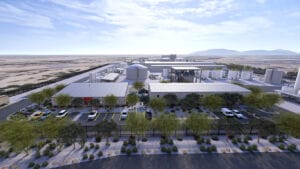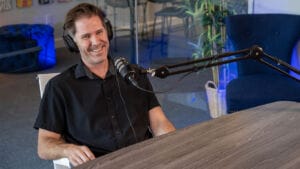The PHX East Valley Partnership made its mark 40 years ago, uniting local leaders to advocate for various regional issues, including business, education, healthcare, housing and transportation.
“It was several years ago that a group like [PHX East Valley Partnership] was asked about their view of the East Valley,” says John Lewis, president and CEO of PHX East Valley Partnership.
BUSINESS NEWS: East Valley mayors cite Top 3 things on to-do lists for 2025
THINGS TO DO: Want more news like this? Get our free newsletter here
“The three words they selected: Talent. Growth. Opportunity. These words led us on how to market our East Valley to companies outside of Arizona.”
Today, the organization remains strong, exemplifying true regional collaboration in action. What better time to gather some of the East Valley’s leaders and stakeholders to discuss the headwinds, tailwinds and future outlook of a thriving region that honors the roots upon which the PHX East Valley Partnership was founded.
Az Business magazine sat down with some of the East Valley’s prominent players to cover a range of topics — from transportation and water to education and workforce. Take a look:
• Kevin Hartke, mayor of Chandler
• Anthony (Tony) Houston, president and CEO of CommonSpirit, Arizona Market
• Mike Hutchinson, executive vice president of PHX East Valley Partnership
• Dr. Shane McCord, superintendent of Gilbert Public Schools
• Dr. Morgan Olsen, executive vice president, treasurer and chief financial officer of Arizona State University (ASU)
• J. Brian O’Neill, executive director and CEO of Phoenix-Mesa Gateway Airport
• Bryant Powell, city manager of City of Apache Junction
• John Lewis, president and CEO of PHX East Valley Partnership
• Julia Wheatley, mayor of Queen Creek
Az Business: What do you see as the PHX East Valley’s biggest achievements over the past decade and what lessons have been learned from these successes?
Mike Hutchinson: Every city has exciting things going on. I think that’s because there’s good leadership at the elected official level and at the management level of the cities, and they work together.
J. Brian O’Neill: You stole my thunder, Mike. I’ve been here 10 years now and there is a unique spirit of cooperation in the PHX East Valley that you will not find in other parts of the country. I also have to give SRP and APS a lot of credit because if you’ve seen the tremendous growth that has gone on in the East Valley, planning to energize all of that is going to be a Herculean task.
Julia Wheatley: I feel like with collaboration, all boats rise. We truly celebrate each other’s successes for the Valley, for the region. We recognize that the work we do and the relationships that we build benefit all of our communities.
Bryant Powell: One of the big successes in the East Valley is what we call acquisition and movement of state land into private hands. The ability for the region to see that happen not just for farmland, but also now state land, is huge. I’m sure back in 1912 in Arizona, they never thought that the metro area would get out there, but we’ve seen that happen now and it has brought tremendous change in the far East Valley.
Az Business: What challenges does the PHX East Valley face as it continues to grow and how can they be addressed collectively?
Kevin Hartke: Certainly long-term, water. We have water, but as we experience more growth, we need to make sure that we’re looking long-range — 20, 30, 40, 50 years down the road — and where the water is coming from, how it is entering our system and how are we all being sustainable.
Shane McCord: I think the challenges that we face for K-12 is communicating to the kids and to the parents that there are pathways in place for workforce development.
I could feel a tremor in The Force when [TikTok] went down. We either have to figure out how to get rid of that stuff or we have to find a way to embrace it. And I think our best choice is to figure out how to embrace it and have the kids bring us along so we can shift gears about how they need to be educated.
MH: We’ve got to keep working on transportation. We’ve done well as a region, but there are still needs out there. We’re not really doing the total job on that. Another is childcare subsidies and how to make childcare readily available. We’ve got to continue to fund these public institutions — ASU, the community college district, the K-12s, the charters.
Az Business: What specific investments in your cities — like downtown revitalization, recreational areas, or infrastructure — are driving economic growth and quality of life?
JW: Downtown in Queen Creek is very exciting right now. We have a lot going on. We just built three new roadways and if you know Queen Creek, we are all in on transportation and investing in the infrastructure for transportation. Building three new roadways is considerable, but especially in our downtown core and creating a vibrant, walkable community.
KH: In Chandler, infrastructure drives so much of what we do because it’s such an important long-term investment. In November, our voters will make a decision on what will probably be about a half-billion-dollar bond that will focus on public safety, building state-of-the-art forensic facilities, supporting our roads, potentially constructing a new fire station and keeping up with our parks and recreation facilities.
BP: As we go further south in Apache Junction — where we’re seeing the growth — we’re working with the land ownerships and the landowner, which for us is the state land department. They definitely have a stake in helping us keep our unique character, our own unique stamp of what our parks are going to look like, our libraries, our street signs and lighting downtown.
Az Business: What industries are emerging around Phoenix-Mesa Gateway Airport and how is the airport’s expansion impacting the region’s economic landscape?
John Lewis: I’ve been on the Gateway board and between what is planned and the exciting things happening with the potential east side terminal — there’s a lot in the works for the three cities.
JBO: Virgin Galactic is opening two facilities and later this year, they’re going to start manufacturing six-seat commercial delta spaceships that are going to go into the space tourism program for Virgin Galactic. We’re also talking about electric vertical takeoff and landing (eVTOL), whether they’re piloted or autonomous. Arizona as a state is trying to position itself to be a leader in this emerging industry. And Phoenix-Mesa Gateway Airport is trying to position itself as a resource and a testing ground as that portion of the air transportation industry continues to evolve.
Az Business: How are educational partnerships preparing the next generation of talent to meet the needs of the East Valley’s growing industries?
Dr. Morgan Olsen: Under ASU President Michael Crow’s leadership, we set up a new part of the university that we call Learning Enterprise. The idea behind Learning Enterprise is that we believe that people should be what we call universal learners, which means that you start learning almost immediately, find your entrance to this world and continue to learn throughout your lifetime.
We run charter schools like ASU Preparatory Academy. We have about seven different locations around the Valley, many offering a hybrid learning experience — which we all learned how important that was during the pandemic — and then fully digital opportunities as well.
ASU has courses that we call Universal Pathways that are about helping people who may not be sure about post-secondary education and the major commitment of both time and money necessary to be successful. It allows students to take a single course or just a few courses and pay nothing to start.
SM: Looking at the number of CTE programs that we provide in our district, I think there are probably 15 to 20 different types across all of our high schools. And East Valley Institute of Technology (EVIT) is such a great opportunity for our students to get even more training. I know that they’re choosing career pathways based on the programs that we have at our high schools and what EVIT offers.
Az Business: What continues to make the workforce pipeline an attractive and essential component for industries considering making the PHX East Valley home?
Tony Houston: At Dignity Health, workforce is incredibly important. In the East Valley — and specifically at our Chandler campus — we’ve brought in residency training programs. We’re in our second year of our five-year buildup in those programs: internal medicine, family practice, OBGYN, emergency medicine and general surgery. We’re growing with over 5,000 employees at Chandler, Gilbert Mercy and Mesa.
JBO: One of our major focuses at the airport is the maintenance, repair and overhaul of aircraft. With Cessna, Embraer, Textron, Gulfstream and now Virgin Galactic — also with Allegiant having a large maintenance base — there is a dire need for a local pipeline of qualified mechanics. I think what’s really interesting is that the region, whether it’s ASU or Chandler-Gilbert Community College (CGCC) or Mesa Community College (MCC), has been working with the companies at the airport to enhance the programming so they can generate this larger pipeline of qualified A&P mechanics.
Az Business: What do you see as the East Valley’s biggest achievements over the past decade and what lessons have you learned from its successes?
JL: When the Lewis family moved here in 1985, we picked Gilbert because of Gilbert Public Schools and a lot of other good school districts nearby. That, by far, is what drew us in. But what was interesting is that the PHX East Valley Partnership was formed in the early 1980s because the East Valley was growing rapidly and we didn’t have infrastructure. And so I’ve just been amazed to see what happened with collaboration.
TH: You’ve got a place to live, you’ve got a place to work, good schools to send your kids to. You’ve got an airport to get in and out of. Why wouldn’t you want to come here? We’ve been so blessed to be on the journey over the last few generations at Dignity Health and it’s incredible to see what the future holds.




